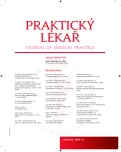Posttraumatic stress disorder
Authors:
K. Látalová; J. Praško; D. Kamarádová; A. Sandoval; D. Jelenová; P. Havlíková; M. Černá
Authors‘ workplace:
Klinika psychiatrie
; Přednosta: prof. MUDr. Ján Praško, CSc.
; Lékařská fakulta Univerzity Palackého v Olomouci a Fakultní nemocnice Olomouc
Published in:
Prakt. Lék. 2014; 94(4): 172-176
Category:
Reviews
Overview
Posttraumatic stress disorder belongs to the group of anxiety disorders. The experience of a stressful event or situation of exceptionally threatening or catastrophic nature precedes the development of PTSD. The disorder is more common in women, people not in a relationship, disabled or socially isolated people. The definite neurobiological hypothesis has not been determined yet. Great attention is paid to changes in the level of the hypothalamus-pituitary-noradrenergic axis. In the clinical picture of PTSD there are typical recurrent, intrusive memories, which appear in the form of flashbacks or nightmares. The progress is usually erratic, most of the patients will have declining symptoms in time. The treatment is often complicated by comorbidities. The antidepressant from the group of the selective serotonin reuptake inhibitors (SSRIs), tricyclic antidepressants, mood stabilizers and antipsychotics proved to be effective in the treatment of PTSD. The anxiolytics can be administered temporarily. There is evidence that the cognitive behavioral therapy is the most effective from the psychotherapeutic approaches. Many patients benefit from a combination of both treatments.
Keywords:
stress – trauma – PTSD – anxiety disorders – therapy – antidepressants – cognitive-behavioral therapy
Sources
1. Abrams TE, Lund BC, Bernardy NC, Friedman MJ. Aligning clinical practice to PTSD treatment guidelines: medication prescribing by provider type. Psychiatr Serv 2013; 64 (2): 142–148.
2. Alvarez J, McLean C, Harris AH, et al. The comparative effectiveness of cognitive processing therapy for male veterans treated in a VHA posttraumatic stress disorder residential rehabilitation program. J Consult Clin Psychol 2011; 79(5): 590–599.
3. Blank AS. The longitudinal course of posttraumatic stress disorder. In: Davidson JRT a Foa EB (eds.) Posttraumatic stress disorder: DSM-IV and Beyond. Washington, DC: American Psychiatric Press 1993.
4. Brady KT, Kelleen TK, Brewerton T, Lucerini S. Comorbidity of psychiatric disorder and posttraumatic stress disorder. J Clin Psychiatry 2000; 61(7): 22–32.
5. Ditlevsen DN, Elklit A. Gender, trauma type, and PTSD prevalence: a re-analysis of 18 nordic convenience samples. Annals of General Psychiatry 2012; 11 : 26.
6. Green B, Griffiths EC. Birth order and post-traumatic stress disorder. Psychol Health Med 2013; 11. [Epub ahead of print]
7. Hetrick SE, Purcell R, Garner B, Parslow R. Combined pharmacotherapy and psychological therapies for post traumatic stress disorder (PTSD). Cochrane Database Syst Rev 2010; (7): CD007316.
8. Koucky EM, Dickstein BD, Chard KM. Cognitive behavioral treatments for posttraumatic stress disorder: Empirical foundation and new directions. CNS Spectrums 2013; 18(2): 73–81.
9. Latalova K, Prasko J, Pastucha P, et al. Bipolar affective disorder and dissociation – comparison with healhy controls. Biomed Pap Med Fac Univ Palacky Olomouc Czech Repub. 2011; 155 : 181–186.
10. Mezinárodní klasifikace nemocí. 10. revize. Duševní poruchy a poruchy chování: Diagnostická kritéria pro výzkum. (přeloženo z anglického originálu) Praha: Psychiatrické centrum 1996; Zprávy č. 134.
11. Možný P, Praško J. Kognitivně-behaviorální terapie: Úvod do teorie a praxe. Praha: Triton 1999.
12. North CS, Kawasaky A, Spitznagel EL, Hong BA. The Course of PTSD, Major Depression, Substance Abuse, and Somatization After a Natural Disaster. JNMD 2004; 192(12): 823–829.
13. Polak AR, Witteveen AB, Visser RS, et al. Comparison of the effectiveness of trauma-focused cognitive behavioral therapy and paroxetine treatment in PTSD patients: design of a randomized controlled trial. BMC Psychiatry 2012; 12 : 166. doi:10.1186/1471-244X-12-166.
14. Powers MB, Halpern JM, Ferenschak MP, Gillihan SJ, Foa EB. A meta-analytic review of prolonged exposure for posttraumatic stress disorder. Clin Psychol Rev 2010; 30(6): 635–641.
15. Praško J. Postraumatická stresová porucha In: Seifertová D, Praško J, Horáček J, Hoschl C (eds.) Postupy v léčbě psychických poruch. Praha: Academia Medica Pragensis 2008; 343–364.
16. Prasko J, Raszka M, Diveky T, et al. Obsessive compulsive disorder and dissociation – comparison with healthy controls. Biomed Pap Med Fac Univ Palacky Olomouc Czech Repub 2010; 154 : 179–183.
17. Prasko, J, Latalova, K, Grambal, A, Kamaradova, D. Off-Label Use of Second Generation Antipsychotics in Anxiety Disorders and Obsessive Compulsive Disorder. Act Nerv Super Rediviva 2010; 52(4): 229–240.
18. Santiago PN, Ursano RJ, Gray CL, et al. A Systematic Review of PTSD prevalence and trajectories in DSM-5 defined trauma exposed populations: intentional and non-intentional traumatic events. PLoS ONE 2013; 8(4): e59236. doi:10.1371/journal.pone.0059236
19. Vermetten E, Lanius RA. Biological and clinical framework for posttraumatic stress disorder. Handb Clin Neurol 2012; 106 : 291–342.
20. Wittchen HU, Jacobi F. Size and burden of mental disorder in Europe: a critical review and appraisal of 27 studies. Eur Neuropsychopharmacol 2005; 15 : 357–376.
Labels
General practitioner for children and adolescents General practitioner for adultsArticle was published in
General Practitioner

2014 Issue 4
Most read in this issue
- Arthritis of the wrist and possibilities of surgical treatment
- Pre-operative assessment and pre-operative preparation in lung surgery
- Posttraumatic stress disorder
- What is „third-hand smoke“?
